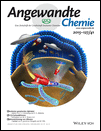Site-Directed, On-Surface Assembly of DNA Nanostructures
Abstract
Two-dimensional DNA lattices have been assembled from DNA double-crossover (DX) motifs on DNA-encoded surfaces in a site-specific manner. The lattices contained two types of single-stranded protruding arms pointing into opposite directions of the plane. One type of these protruding arms served to anchor the DNA lattice on the solid support through specific hybridization with surface-bound, complementary capture oligomers. The other type of arms allowed for further attachment of DNA-tethered probe molecules on the opposite side of the lattices exposed to the solution. Site-specific lattice assembly and attachment of fluorophore-labeled oligonucleotides and DNA–protein conjugates was demonstrated using DNA microarrays on flat, transparent mica substrates. Owing to their programmable orientation and addressability over a broad dynamic range from the nanometer to the millimeter length scale, such supramolecular architecture might be used for presenting biomolecules on surfaces, for instance, in biosensor applications.




